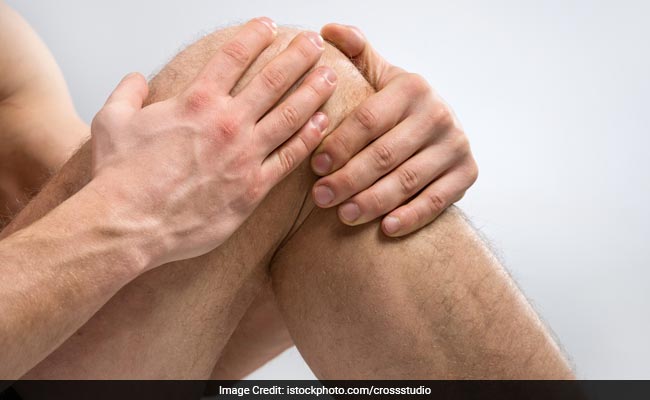Arthritis dis
Arthritis guide
Arthritis
What is it?
Most people above the age of 50 start developing wear-and-tear of the various joints in the body with breakdown of the cartilage cushion in the joints. This causes the bones in the joints to become rough. This condition is known as osteoarthritis and mainly affects the weight-bearing joints like the knees, the hips and the joints in the vertebral column (mainly in the neck and the lower back). The joints that may have had injuries at a younger age are especially prone to develop osteoarthritis. There is also a familial form that affects the hands. Osteoarthritis is seen much more often in women than in men, especially its familial form. Fortunately, osteoarthritis is a disease only limited to the joints and does not involve the rest of the body. Also, inflammation is not a major feature of osteoarthritis. Thus, osteoarthritis may be classified as chronic non-inflammatory arthritis mainly related to aging and wear-and-tear. Because it is mainly a mechanical disease and not a systemic inflammatory disease, it is not a life threatening disease. The other older age joint disease, seen almost exclusively in men is gout. Gout is almost never seen below 40 years of age. It is also almost never seen in young women (before the onset of menopause, unless there is a known underlying kidney disease) and never seen in children. It is traditionally associated with affluent and rich men who usually have a strong family history of obesity, heart disease, high blood pressure, diabetes mellitus and high blood lipids (high cholesterol etc.). They eat and drink well. They are usually obese. They do not exercise and have a propensity to develop the diseases mentioned above. Gout is the commonest inflammatory arthritis of adult men in the world. It usually appears suddenly with acute red-hot exquisitely painful swelling of the joint at the base of the big toe. It is caused by the presence of crystals of a chemical substance called uric acid (urate crystals) that seems to be increased in such individuals. The cause of increased uric acid is both familial as well as related to the specific life-style mentioned above. It is especially relevant to India for, a large segment of urban population of the newly rich, is rapidly acquiring such a life-style.
What are the types?
Yes, there are a variety of different types of arthritis. One can look at different types of arthritis according to the: Age group and gender. Presence or absence of inflammation in the joints, a specific clinical feature that rheumatologists are trained to recognise by simple history of the joint symptoms. Duration of joint symptoms (<6 weeks or >6 weeks) that classifies them into acute and chronic forms of arthritis that are 2 entirely distinct categories of diseases. The number of joints affected (only one joint [called monoarthritis], 2 to 4 joints [called oligoarthritis or pauciarthritis] or more than 4 joints [polyarthritis]Possibly the best and the easiest way to understand them is to remember them according to the age group and gender
What is the treatment?
As arthritis is not a single disease, treatment differs depending upon its type. However, the common goal of treatment is to keep the joints moving properly by relieving the pain and stiffness and by reducing swelling. In general, simple pain relievers like paracetamol, tramadol, and more ‘strong’ drugs called non-steroidal anti-inflammatory drugs (NSAIDs e.g. aspirin, ibuprofen, indomethacin, diclophenac, naproxen, aceclofenac, piroxicam, meloxicam, and the newer drugs like celecoxib, etoricoxib) are often used for short periods, especially in acute cases, early stages and in minor forms of arthritis. NSAIDs should never be used continuously daily over prolonged periods because they are very toxic and have a large number of serious side-effects. In severe systemic forms of crippling and often life-threatening arthritides (e.g. rheumatoid arthritis, psoriatic arthritis, systemic lupus erythematosus and others in this group) a special group of medicines called ‘disease modifying drugs’ (DMARDs) are given. These drugs have been proven to be highly effective, with good safety margin especially if given under the supervision of a rheumatologist who is well trained in their use. The newer DMARDs include methotrexate, hydroxychloroquine, sulfasalazine, and leflunomide. The older ones included gold-salts, D-penicillamine and chloroquine. The newer DMARDs are highly effective in patients with rheumatoid arthritis, and other severe systemic life-threatening forms of arthritis. But, these drugs are required to be usually given continuously for prolonged periods under the supervision of rheumatologist; often life-time. There is a third category of drugs sometimes used in severe serious forms of arthritis called immunosuppressive drugs. This category includes cyclosporine, cyclophosphamide, and azathioprine. Another category of medicine that is often used in some types of arthritis is called glucocorticoid (commonly called ‘steroids’ or corticosteroids). These are ‘adjunct drugs’ that are always used in combination with DMARDs during the early stage of the initiation of DMARD-treatment only for a short period of time till the slow-acting DMARDs start taking full effect. Glucocorticoids are also highly effective in some of the life-threatening serious forms of arthritis (e.g. systemic lupus erythematosus, systemic vasculitis etc.) where they are used as ‘emergency life saving drugs’. ‘Depot-preparations’ of glucocorticoids are also very useful and effective in controlling inflammation in joints when given as intra-articular injections. In fact, this method of treatment is highly effective and safe for patients who may have only a few inflamed joints. On the other hand, if a joint needs repeated injections of depot-preparations of glucocorticoids giving only temporary relief, a specialist must be consulted for proper treatment. Glucocorticoids should also never be given as ‘stand-alone’ drugs for arthritis and they should never be given as daily dose for prolonged periods of time, especially so without supervision of a rheumatologist. If not used appropriately, glucocorticoids can cause serious side effects. The latest category of drugs for serious systemic life threatening forms of arthritis (namely rheumatoid arthritis, spondyloarthritis-ankylosing spondylitis, diffuse connective tissue diseases, systemic vasculitides) are called biological response modifiers (BRMs) or simply ‘biologicals’. These are highly effective drugs that are changing the outcome in these serious crippling life threatening diseases of young men and women dramatically. Infliximab (‘Remicade’®), etanercept (‘Enbrel’®) and rituximab (‘Mabthera’®) are already available in India. Adalimumab (‘Humira’®), abatacept (‘Orancia’®) are likely to become available in India in the near future. However, presently their price is beyond the reach of common man (a single dose may cost more than 1 lakh rupees). Also, these drugs must be given only by specialist rheumatologist with precautions to prevent adverse effects. Controlling the weight AND REDUCING will reduce strain on weight-bearing joints. Exercise and physiotherapy help in keeping the muscles strong and movement of the joints as normal as possible. Proper occupational therapy would prevent further damage, maintain muscle power and help in coping with the functions of daily living. Severely damaged hips and knees may need to be surgically replaced by specialist orthopaedic surgeons. That is the stage at which the consultation with Orthopaedic specialists is required. Specific treatment for the commonest form of arthritis i.e. osteoarthritis (the arthritis of ‘joint aging’), is fairly simple in the early stages. Weight reduction, avoiding activities and posture that further damage the joint, regular exercises to build up the muscles that support the involved joints (under the guidance of a trained physiotherapist), and the occasional use of simple anti-inflammatory drugs (non-steroidal anti-inflammatory drugs, mentioned above) prescribed by a physician, is all that is required. In advanced cases joint replacement surgery is a fairly safe and highly effective method of treatment with excellent long-term results.Rheumatoid arthritis and other systemic inflammatory arthritides like psoriatic arthritis and arthritis related to diffuse collagen diseases need the expertise of rheumatologists for prolonged, intense, and specialized form of treatment with disease modifying drugs (mentioned above). Ignoring or delaying appropriate consultations and treatment may lead to serious complications. The same is true of juvenile chronic arthritis seen in childhood and juveniles. Joint infections are acute rheumatological emergencies. They require prompt diagnosis and appropriate antibiotic and surgical treatment including drainage of pus from the joints. Any delay may lead to permanent damage. Treatment of gout needs special mention because the disease is preventable. Although the tendency to develop gout is hereditary, there are several life-style related factors that predispose the person to attacks of gouty arthritis. These include sedentary habits, lack of exercise, obesity, excess food intake especially of rich refined, high-calorie food including sea-food, a lot of red meat, some forms of alcoholic drinks especially beer, fermented food (that contain yeast e.g. ‘Mughlai food’). An acute attack is usually precipitated after a late-night party with a lot of eating and drinking, or sometimes after an injury or any other stress like surgery, or infection. Thus, in persons with a family history of gout, a diet restricted in calories, with lots of fruits and salads (high in soluble as well as insoluble fibres), complete avoidance of sea-food, red meat and fermented food, regular exercise to keep the weight under control, abstinence from alcoholic drinks (especially beer), prevents attacks of gout. This would also prevent the other diseases often associated with gout such as, high blood pressure, abnormalities of blood lipids (including high ‘bad’ cholesterol [LDL-cholesterol], and high triglycerides) that may lead to heart attack and stroke, and diabetes. Certain drugs (e.g. diuretics for the treatment of fluid retention) also predispose to gouty attacks. However, if despite these restrictions the person gets an acute attack of gout; it must be considered a rheumatological emergency. Urgent consultation with a rheumatologist is necessary. Strong non-steroidal anti-inflammatory drugs and local injection of depot-preparation of glucocorticoids into the joint bring about immediate and dramatic relief. An important point to remember is to avoid a drug called allopurinol, which is the standard drug for preventing accumulation of uric acid in the body of persons with a tendency to develop gout. Giving this drug for in the early stages of an up-coming acute attack of gout will rapidly worsen the condition.
What are the prevention?
Some kinds of arthritis are preventable but others are not. Thus, the progression of osteoarthritis can be arrested with appropriate exercises, weight reduction and preventing posture and movement that worsen the disease. Similarly, as mentioned above, gout is preventable with changes in life-style. Avoiding unprotected sex prevents gonorrhoea-related arthritis and most cases of so-called ‘reactive arthritis’. Avoiding gastroenteritis (not eating in restaurants, especially where the hygiene is questionable) may also prevent ‘reactive arthritis’. In children with a definite history of rheumatic fever, avoiding crowded quarters (where there is increased chances of throat infection), and regularly taking penicillin treatment may prevent further attacks.Unfortunately, the most serious crippling, and occasionally life-threatening form of arthritis like rheumatoid arthritis, psoriatic arthritis and diffuse collagen diseases including systemic lupus erythematosus are not preventable because their root-cause is in the genes and the genes cannot be changed or removed from the body (at least till now!). Fortunately the progressive damage to the joints and other organs in the body can be prevented with early correct diagnosis and aggressive modern treatment.
Arthritis News More News
- This Plant Could Help Treat Diabetes, Arthritis And Other Medical Conditions
- Did You Know This About Marathon Runners?
- Beware! Those Extra Kilos Can Increase Your Risk Of Arthritis
- Baking Soda May Help Combat Rheumatoid Arthritis
- Scorpion Venom Can Improve Treatment For Rheumatoid Arthritis
- Here's How Using Complex Inhalers Can Affect Patients
- After Lungs, Polluted Air Targets Your Bones: Tips To Reduce Air Pollution
- Eating Fish Can Help Treat Arthritis: Study
- Depression may boost arthritis pain
................... Advertisement ...................
................... Advertisement ...................
................... Advertisement ...................
................... Advertisement ...................






























